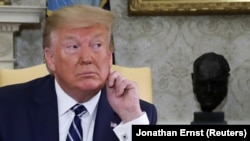U.S. President Donald Trump signed an executive order imposing "hard-hitting" sanctions on Iran, including on the office of Supreme Leader Ayatollah Ali Khamenei, as tensions between the two nations heat up.
The sanctions will deny Iran’s leader and those close to him “access to key financial resources and support," Trump said as he signed the document in the Oval Office on June 24.
Trump said he will “continue to increase pressure” on Iran until the regime ends its “dangerous activities and its aspirations,” including its pursuit of nuclear weapons, development of ballistic missiles, and support of terrorism.
However, he pointed out that the United States doesn’t “ask for conflict” and added that depending on Iran's response the sanctions could end tomorrow -- or it "can also be years from now."
The new round of sanctions also includes eight members of Iran’s Islamic Revolutionary Guards Corps. It will lock up billions of dollars in Iranian assets, Treasury Secretary Steven Mnuchin said.
Mnuchin added Trump has authorized him to impose sanctions on Iran’s Foreign Minister Mohammad Javad Zarif this week.
Shortly after the new sanctions were announced in Washington, Zarif said on Twitter that some U.S. politicians “despise diplomacy.” Zarif accused the Trump administration of having a “thirst for war.”
Iranian hard-line media said the new sanctions are based on “fabricated” accusations.
The sanctions come as tensions between Iran and the United States escalate, raising concerns the U.S. could pursue military action against the Islamic regime.
Gulf Tensions
U.S. Secretary of State Mike Pompeo met June 24 with leaders in Saudi Arabia and the United Arab Emirates as he seeks to build a coalition against Tehran.
The U.S. accused Iran of sabotaging two oil tankers earlier this month in the Gulf of Omen, which Tehran denies.
Last week, Iran shot down a U.S. military drone it said was flying over its territory. The United States has said the drone was in international skies.
Trump said on June 21 that he came within minutes of executing strikes against Iran in retaliation for the downing of the drone. He left open the question of a military response.
“Who knows what is going to happen? I can only tell you we cannot ever let Iran have a nuclear weapon,” said Trump, adding he is open to talks with the country’s leaders.
Trump made taking a tough stance toward Iran and its nuclear program a key element of his 2016 campaign and has followed through on that promise since coming to power.
Last year, he withdrew the United States from the 2015 Iran nuclear deal that sought to curb the country’s nuclear program in exchange for an easing of sanctions.
Former U.S. officials and allies called Trump’s action's a mistake.
Trump called the agreement “short-sighted” and claimed that under its terms Iran would have been able to develop nuclear weapons in a few years.
“The [2015] agreement that was signed was a disaster. It was not doing what it was supposed to do,” he said June 24.
The president has imposed sanctions on more than 900 Iranian individuals and companies since 2018, squeezing the oil-producing nation financially.
Earlier this month, his administration imposed sanctions on Persian Gulf Petrochemical Industries Company, the country’s largest petrochemical company and one of its biggest exporters.



